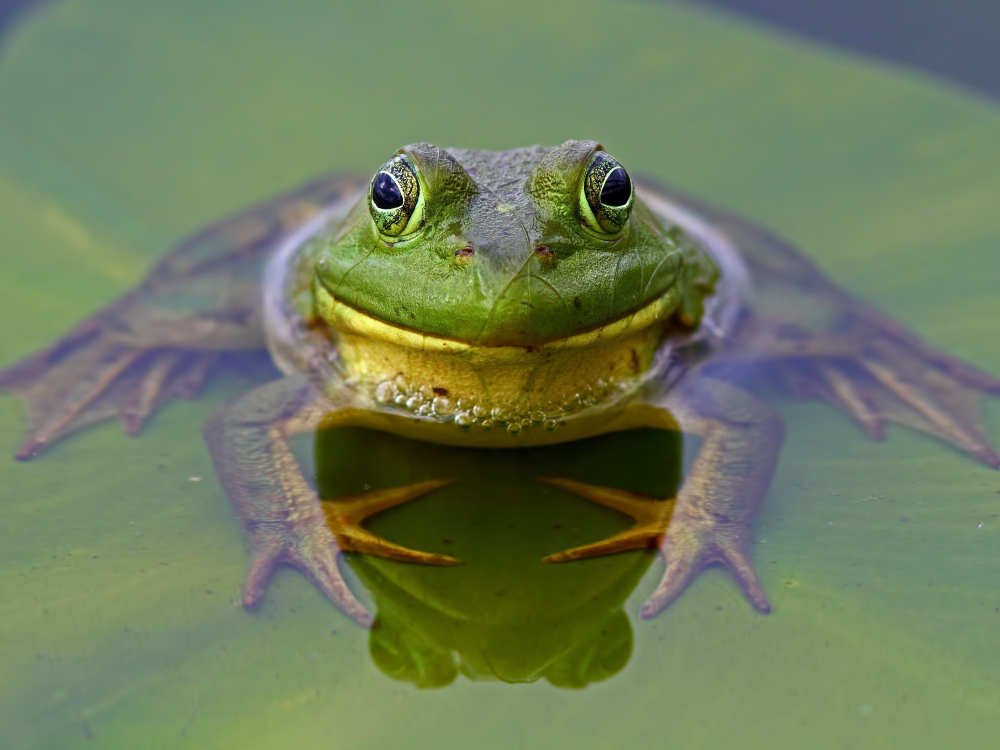Bullfrog, often celebrated as the giants of the frog world, are not just remarkable for their size but also for their unique characteristics and ecological significance. Found across various regions of the world, these amphibians have fascinated scientists and nature enthusiasts alike for centuries. In this article, we delve into the intriguing world of bullfrogs, exploring their habitat, behavior, role in ecosystems, and the challenges they face in terms of conservation.
Biology and Characteristics
Scientifically known as Lithobates catesbeianus, bullfrogs are characterized by their large size, robust build, and distinctive deep calls that resemble the bellowing of a bull, hence their name. They belong to the family Ranidae, which encompasses true frogs.
One of the most striking features of bullfrogs is their size. They are among the largest frog species in the world, with adult males often reaching lengths of up to 6 inches or more, excluding their powerful hind legs. Females are generally larger than males. Their coloration varies, typically ranging from shades of green to brown, helping them blend into their surroundings, whether in water or on land.
Habitat and Distribution
Bullfrogs are native to North America, specifically the eastern and central regions, although they have been introduced to other parts of the world, including Europe, South America, Asia, and Africa, primarily for commercial purposes such as food and pest control. They inhabit a variety of freshwater habitats, including ponds, lakes, marshes, and slow-moving streams, preferring areas with ample vegetation for cover and hunting.

Behavior and Diet
These amphibians are predominantly nocturnal, becoming active at dusk and throughout the night. During the day, they often seek shelter in vegetation or burrow into the mud to avoid predators and regulate their body temperature. Bullfrogs are voracious predators, feeding on a wide range of prey, including insects, small fish, crustaceans, amphibians (including other frogs), and even small mammals and birds. Their diet is opportunistic, and they are known to ambush prey by remaining motionless until an unsuspecting victim comes within striking distance.
Reproduction
Bullfrog is popular for its loud and distinctive calls, which males use to attract females during the breeding season. These calls, often heard during the spring and summer months, are an integral part of courtship and territorial behavior. Once a female selects a mate, she lays her eggs in shallow water, attaching them to submerged vegetation. A single female can lay thousands of eggs in a gelatinous mass, which hatch into tadpoles within a few days. Tadpoles undergo metamorphosis, gradually developing into froglets over several weeks before leaving the water.
Ecological Importance
Bullfrogs play a crucial role in the ecosystems they inhabit. As both predators and prey, they help regulate populations of various organisms, contributing to the balance of freshwater ecosystems. Their tadpoles consume algae and detritus, helping maintain water quality, while adult bullfrogs control insect populations, including mosquitoes, which can carry diseases harmful to humans. Additionally, bullfrogs serve as prey for a variety of predators, including birds, mammals, and other amphibians, forming an essential component of food webs.
Conservation Challenges
Despite their ecological importance, bullfrog populations face numerous threats, primarily due to habitat loss, pollution, invasive species, and overexploitation. The introduction of bullfrogs to regions outside their native range has led to competition with native species and the spread of diseases, further exacerbating their impact on local ecosystems. Additionally, commercial harvest for food and the pet trade has resulted in population declines in some areas.
Conservation efforts aimed at protecting bullfrog populations include habitat restoration, captive breeding programs, and the regulation of trade and harvesting. Public awareness and education campaigns also play a vital role in promoting the conservation of these amphibians and their habitats.
Conclusion
Bullfrogs, with their impressive size, unique characteristics, and ecological significance, represent an essential component of freshwater ecosystems. Understanding their biology, behavior, and the challenges they face is crucial for their conservation. By addressing threats such as habitat loss, pollution, and overexploitation, we can work towards ensuring the continued survival of these fascinating amphibians for generations to come.









